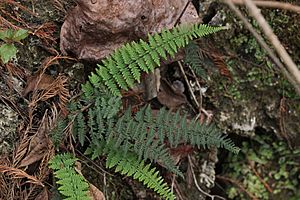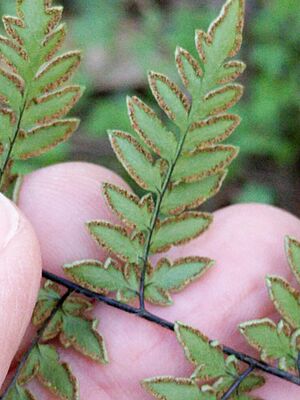Alabama lip fern facts for kids
Quick facts for kids Alabama lip fern |
|
|---|---|
 |
|
| Myriopteris alabamensis growing on a slope | |
| Conservation status | |
| Scientific classification | |
| Genus: |
Myriopteris
|
| Species: |
alabamensis
|
| Synonyms | |
|
|
The Myriopteris alabamensis, also known as the Alabama lip fern, is a medium-sized fern. You can find it growing in the United States and Mexico. It belongs to the Pteridaceae family. Unlike many ferns in its group, its leaves have very few hairs, or sometimes none at all.
For a long time, this fern was called Cheilanthes alabamensis. But in 2013, scientists decided to put it in a different group called Myriopteris. This was because new studies showed it was more closely related to other ferns in the Myriopteris group. The Alabama lip fern usually grows in shady spots on limestone rocks.
Contents
What Does the Alabama Lip Fern Look Like?
The Alabama lip fern grows from a root-like stem called a rhizome. This rhizome is about 1 to 7 millimeters (0.04 to 0.28 inches) thick. It has small, flat scales that are brown or orange-brown.
The fern's leaves, called fronds, grow in bunches. They don't unroll like typical fern "fiddleheads." When they are fully grown, they can be 6 to 50 centimeters (2.4 to 20 inches) long and 1 to 7 centimeters (0.4 to 2.8 inches) wide. The stalk of the leaf, called the stipe, is black and covered with fine, whitish or yellowish hairs. It can be 3 to 23 centimeters (1.2 to 9.1 inches) long.
The main part of the leaf is shaped like a spear or a long rectangle. It is usually divided into smaller sections, like a feather. The main stem of the leaf (the rachis) is dark and has twisted hairs. The smaller leaf parts (called pinnae) are slightly smaller at the bottom of the leaf. The top surfaces of the pinnae have only a few soft hairs or no hairs at all. The smallest leaf parts (pinnules) are oval or long and triangular. They are 3 to 7 millimeters (0.12 to 0.28 inches) long and may have a few white hairs or no hairs.
On fertile fronds, the fern produces sori. Sori are small clusters of spore-producing structures. They are found on the underside of the leaf. The edge of the leaf curls back to protect these sori, forming a false indusium. These false indusia are about 0.1 to 0.4 millimeters wide.
Each sporangium (a tiny case holding spores) in a sorus contains 32 spores. Most of these ferns reproduce without needing two parents (this is called apogamous reproduction). They have three sets of chromosomes (they are triploid). Some ferns in Mexico, however, reproduce sexually and have two sets of chromosomes (they are diploid).
How the Alabama Lip Fern Got Its Name
The common name "lip fern" comes from where the spore cases (sporangia) are located. They are found along the edge, or "lip," of the leaf.
The first time this fern was officially described was in 1843 by Samuel Botsford Buckley. He found it growing on limestone rocks near the Tennessee River in Muscle Shoals, Alabama. He named it Pteris alabamensis after the place where he found it. This is also how it got the common name "Alabama lip fern."
Later, in 1847, another scientist named Gustav Kunze moved the fern to the genus Cheilanthes, calling it C. alabamensis. This name was used for most of the 20th century.
In recent years, scientists have used new methods, like studying the fern's DNA, to understand how different ferns are related. These studies showed that the old way of grouping Cheilanthes ferns was not quite right. Many ferns that looked similar had actually developed those traits separately because they lived in similar dry places.
Because of this new evidence, in 2013, scientists Amanda Grusz and Michael D. Windham decided to bring back the genus Myriopteris. They moved many ferns, including C. alabamensis, into this new group. So, the Alabama lip fern's scientific name became Myriopteris alabamensis.
Where Does the Alabama Lip Fern Live?
In the United States, you can find the Alabama lip fern in the southern Appalachian Mountains, from Virginia and North Carolina down to the south. It also grows in the Ozarks, along the southern borders of Arizona, New Mexico, and Texas. You can also find a few isolated groups in the Mississippi Valley and on the east coast of Florida. In Mexico, it lives in the northern states and south through central Mexico to Oaxaca.
This fern usually grows on limestone cliffs and ledges. It can also be found on the ground among limestone rocks or on shell mounds. It likes shady places. You can find it at different heights, from about 100 to 2400 meters (330 to 7,900 feet) above sea level.
Conservation Status of the Alabama Lip Fern
Overall, the Alabama lip fern is considered a secure species. However, it is facing threats in many states, especially in the northern and eastern parts of its range. It has completely disappeared from Louisiana and is only known from historical records in Kentucky.
Organizations like NatureServe consider it to be in critical danger in Kansas, Mississippi, Missouri, North Carolina, Oklahoma, and Virginia. It is considered endangered in Georgia and vulnerable in Alabama.
Growing the Alabama Lip Fern
You can grow the Alabama lip fern in gardens. It needs medium-high light and soil that is alkaline (not acidic) and sandy. The soil should be dry to slightly moist.



